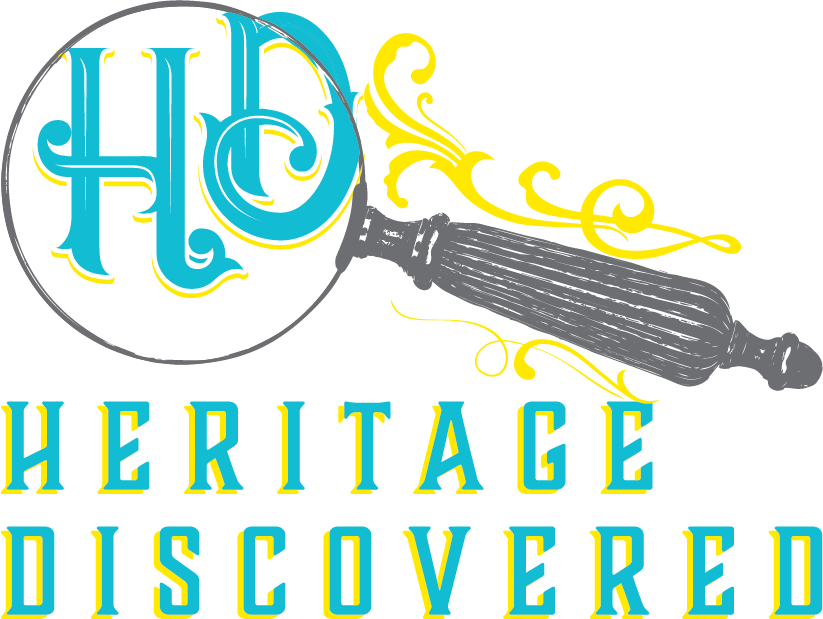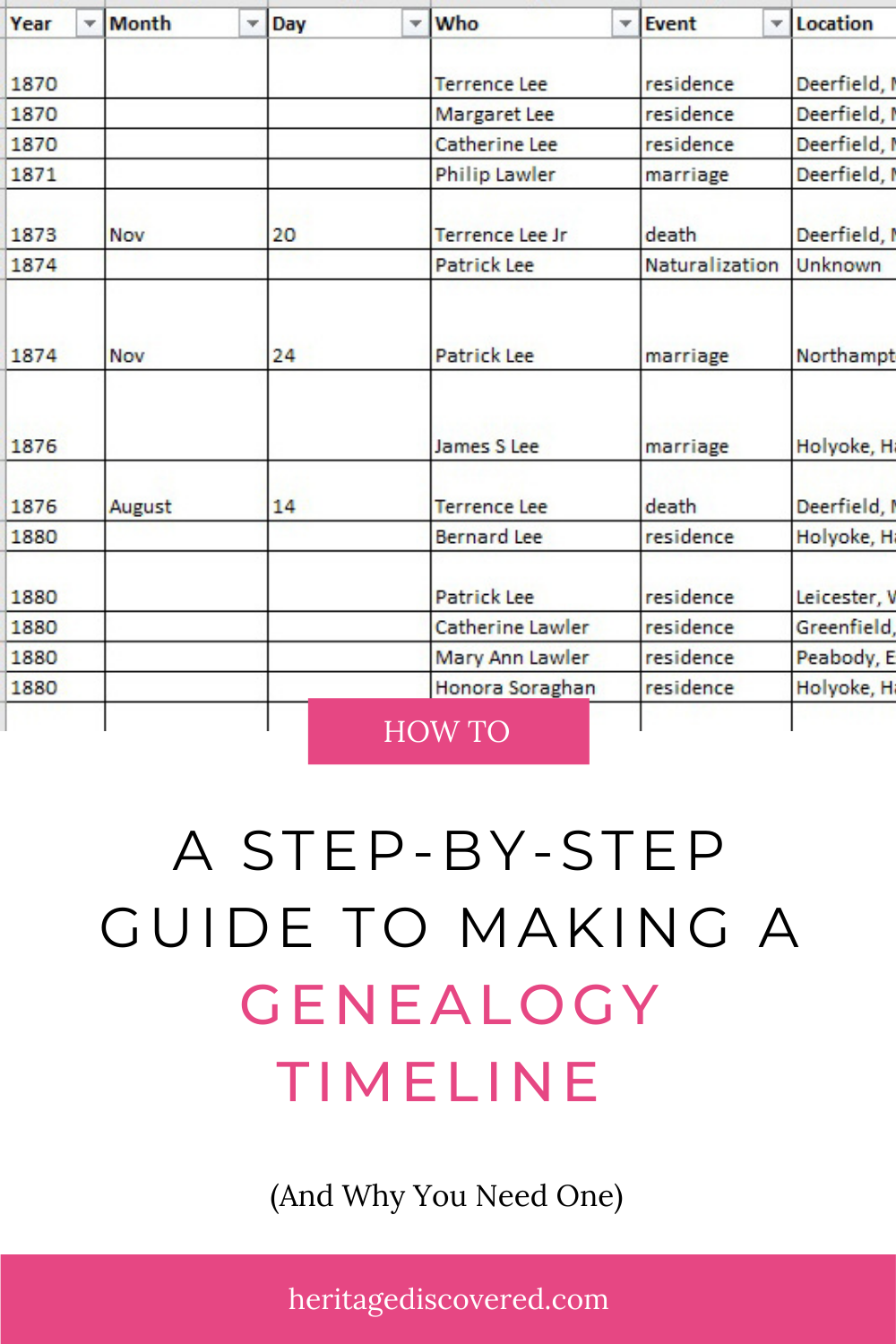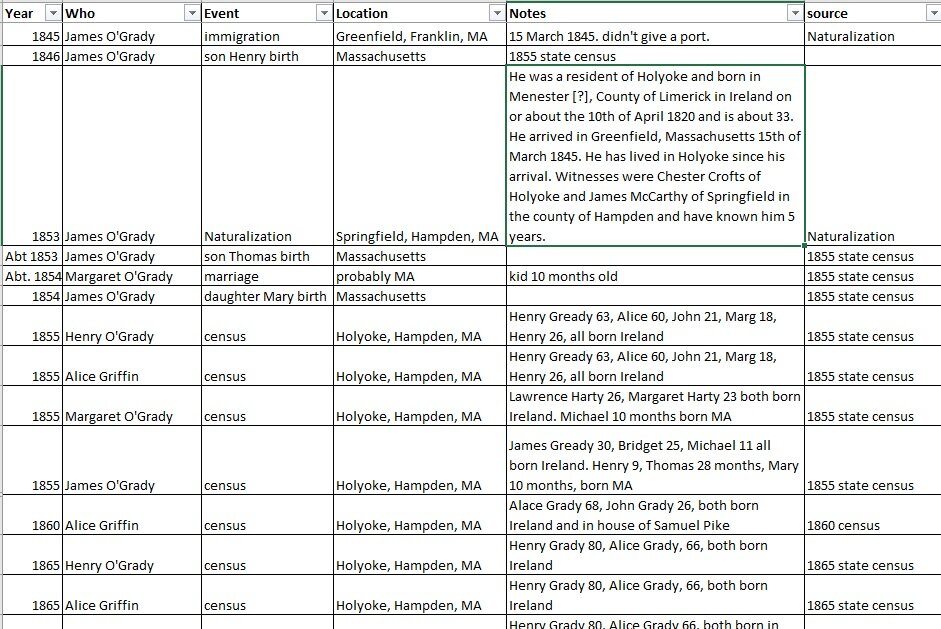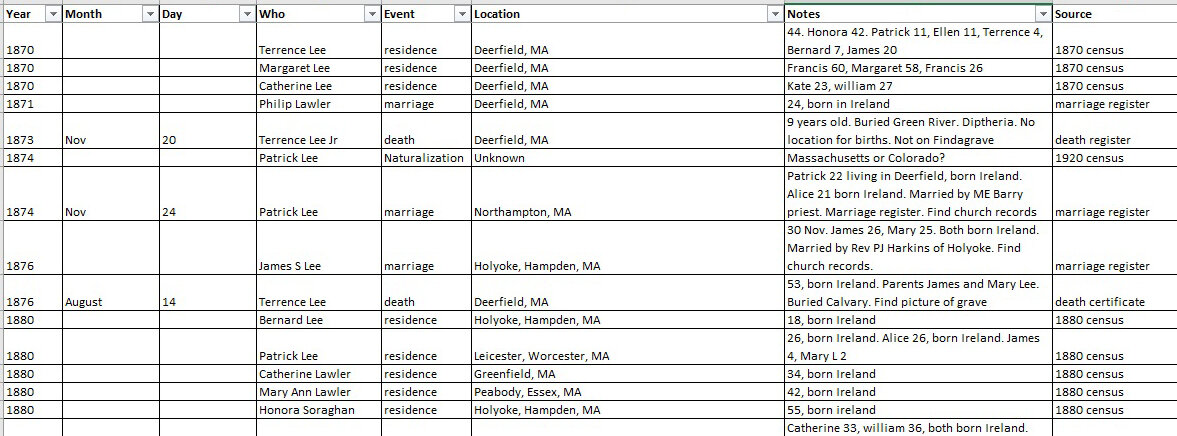7 Simple Steps To Creating A Genealogy Timeline (And Why You Need One)
*This post may have affiliate links, which means I may receive commissions if you choose to purchase through links I provide (at no extra cost to you). All opinions remain my own.
I used to get a little overwhelmed trying to track the lives of all the different branches on my family tree.
My tree software is great for recording things, but I have to click open each event to see any notes. The reports are good, but I can only see the events for one person, making it harder to understand a family group.
I realized I needed another method to see everything that I wanted in one place – a genealogy timeline to see exactly what was happening where, and to whom.
I like Excel and had used it to track other things, so I decided to give it a try in making a genealogy timeline. It made things much easier for me.
How timelines help your genealogy
Timelines are a great tool for your genealogy research, especially for when you come up against a brick wall for one of your ancestors.
They help you:
1) Spot any missing gaps. Have a huge hole in your information? What records can you find to fill that in?
2) See any issues. Does any information conflict? Is anyone in two places at once?
3) Track name changes. When and where were they using a name?
4) Sort people with common names out. Some of us have families where first names were used every generation and kids’ names were recycled by parents.
5) Record how long someone lived at an address or worked for a company.
6) Narrow down the range of the birth/death/other event year if you don’t have any document with clear evidence.
All of this can lead you to other records with more information and evidence.
Related posts:
How to Organize Your Genealogy Files With Binders
How to create a timeline in Excel
There are a bunch of different options for making your family history timeline, like Evernote or a simple Word document.
For easily laying out and sorting information, as well as spotting issues and gaps in, Excel is a great option, as is Google Sheets.
I keep mine simple because I have a separate detailed transcription for every record for a person. The timeline distills all that detail into an easily scannable document.
I like to have a timeline for an entire family group so I can see the bigger picture for the family as a whole.
I can see in which order people immigrated, how the family was moving around as a group, and where to do some collateral research.
What categories of information should you include? Think who, what, when, where, and why.
1) The date. Sometimes you don’t have a complete date for something, like a city directory. In these cases, use the year or the month and year. See below for tips on inputting this.
2) Which person is the information for? If yours is for one person, rather than a family, an option would be to record what name they used for that event. This can also track name changes, like when a woman got married or an immigrant altered their name.
3) The type of event. Was it a birth, a census, or did they start their military service?
4) Location. Be specific where possible and include the town, county, and state/country.
5) Notes. This column can be used in a variety of ways, depending on what makes sense to you. You can add in brief notes from the record that don’t fall under these columns. You can add alternate spellings of names, when vital records began, or anything else that could aid your research. This can also be used to write down next steps, (or you can add another column in for it). It’s good practice to write down any ideas about other places to research that come up while you review your timeline when they’re still fresh in your mind.
6) Source. I prefer to keep the source simple here because I have the formal citation somewhere else. But you can use a full citation if that makes more sense to you. What’s important is to somehow record where you got the information from.
7) Historical events - local and global. This is an optional field, but it can put your ancestor’s world into perspective and see what events could have been impacting their lives at that time.
It may give you insight into why your ancestor may have moved or immigrated. I had a client whose family was from Mexico. They moved to Texas the year the Mexican Revolution started, helping the client understand why his family moved in the first place.
It can also point out other records to look for. Was there a war going on? Maybe they joined the military.
You don’t need to list every thing going on in the world, but adding historical events like wars, famine, or other events that would affect them can give you some context into what they may have been experiencing.
Related posts:
How To Use Online Family Trees The Right Way
5 Things to Look For in Probate Records to Help Trace Your Ancestors
11 of the Best Websites for Free Ship Passenger Lists
What to include in genealogy timelines
Which events should you enter into your timeline? All of them!
Even if you only know the approximate year of an event, it’ll narrow down the years and places you need to research. You’ll be track them as they move, so you can focus your research efforts on the areas they were most likely to be during a certain time period.
Review all the records you have for a person or family that you’re making it for, even those like gravestone images, and input them into your spreadsheet.
Births, marriages, and deaths
Censuses
Burial dates
Baptisms and confirmations
School years
Addresses
Military service
Newspaper articles and obituaries
Court and probate records
When they bought or sold property
When they immigrated or moved
Naturalization years
Employment information
Related posts:
6 Common Genealogy Mistakes And How To Avoid Them
How to Find and Use Hidden Clues in Obituaries
How to Strengthen Your Cemetery Research Skills to Find More Clues
Lee family example
Here is part of a timeline that I created for one of my Irish branches, Terrence Lee and Honora Sullivan/Soraghan.
The family of Terrence’s sister, Margaret, is also on here. They are the only two known siblings and putting both families on one document is helping me to see movements in Ireland and immigration to the US.
I’ve included all of the types of events that I mentioned above. But I also put in when the local Catholic church was founded – 3 years after they arrived.
Where did they attend church before that? This is something for me to look into that wouldn’t have been as easy to realize without a timeline.
Making this also pointed out an issue I hadn’t thought of from looking at my tree software.
In my tree, I have a Delia Lawler and a Bridget Lawler, both daughters of Margaret Lee and Francis Lawler. Delia is the American version of Bridget, but these two people had a five-year age difference.
Are they the same person or did one die young and another Bridget was born? I have only one record for Bridget, baptized in Ireland in January 1849. I have several records for Delia with her family in Massachusetts, with births ranging from 1844 to March 1849. Putting the entire family on one timeline showed me these two children are probably the same person and that I need to do more digging to confirm it.
Related posts:
Everything You Need to Know About Using Home Sources
Solve Your Genealogy Brick Wall: How To Research A Last Name In An Area
Can’t Find Your Women Ancestors? You Need To Try Using Religious Records
Tips for creating and using your timeline
Some tips for maximizing your timeline are:
1) Take advantage of the filter and sorting features, especially if you’re tracking many people on one spreadsheet. For example, if you sort by the 1860 census, you can see if there are any family members you may have missed.
You can filter events for one person, so you don’t have to create separate documents for people from the same family.
2) Be careful about inputting dates into Excel because it can get dicey. As Amy Johnson Crow points out, Excel is really wonky for entering and sorting dates.
You may not have a complete date for an event, and only a year or a month and a year. Excel doesn’t let you enter complete and partial dates in a consistent format, and sorting can put things more out of order.
For example, if you input a mix of date formats like this:
And then try to sort it, it turns into this:
Not helpful if the 1800s and earlier dates don’t sort correctly.
So, before you enter the date, pick a format. I like to have separate columns for year, month, and day. It feels like it's fewer steps and easier to sort and read, but that’s my personal preference.
Google Sheets is much better about sorting, even if you only have partial dates. But if you ever want to download from Sheets into Excel, you could run into problems.
3) Customize your timeline. A fun feature of spreadsheets is being able to color code cells, rows, and columns. Play around with color coding names or certain events, or even your ideas for next steps.
Final thoughts
No matter what format or program you use, timelines are a great way to get your research organized and see where there might be problems or where you can look for more records. Spreadsheets are a good method because of features like the ability to sort, add more rows, and filter. Creating a timeline in Google Sheets or Excel is simple and customizable, so you can make it work in the way that’s best for you.
Have you ever used a timeline for your genealogy work before? If so, how did it help you?







